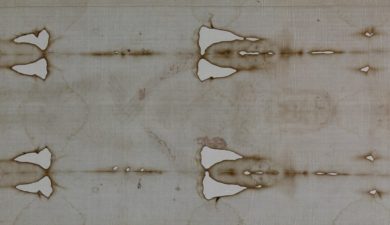February 28, 2022
Southwick parish to host ‘Shroud Encounter’ March 5 and 6
REGIONAL
Staff report

Pope Francis touches the case holding the Shroud of Turin after praying before the cloth in 2015 at the Cathedral of St. John the Baptist in Turin, Italy. (CNS photo/Paul Haring)
SPRINGFIELD – Our Lady of the Lake Parish, located 224 Sheep Pasture Rd. in Southwick, will host the “Shroud Encounter” presentation on Saturday, March 5 at 6 p.m., and Sunday, March 6 at 1 p.m. Admission is $10. Children under 18 are free.
“Shroud Encounter” is a production of the Shroud of Turin Education Project, Inc., and will be presented by international expert Russ Breault. The presentation is a fast-moving, big-screen experience using over 200 images covering all aspects of Shroud of Turin research. A museum quality life-size replica will be on display.
Breault has been featured in several national documentaries seen on CBS, History Channel, EWTN, and Discovery. He has been interviewed for Good Morning America and ABC World News Tonight and was a consultant for CNN’s Finding Jesus series. He has presented at numerous colleges and universities including Duke, West Point, Johns Hopkins, Penn State and many others. (More information can be found at www.ShroudEncounter.com.)
The Shroud of Turin is the most analyzed artifact in the world yet remains a mystery. The 14-foot long linen cloth has been in Turin, Italy for over 400 years and bears the faint front and back image of a 5’10” bearded, crucified man with apparent wounds and bloodstains that match the crucifixion account as recorded in the Bible. Millions of people over the centuries have believed it be the actual burial shroud of Jesus. The historical trail tracks back through Italy, France, Asia Minor (Turkey) and may have originated in the Middle East according to botanical evidence.
A team of nearly 40 scientists in 1981 concluded it was not the work of an artist. They found no visible trace of paint, pigment, dye, or other artistic substances on the cloth. The blood is type AB with human male DNA as determined in 1995. Skeptics have mounted numerous attempts to show how a medieval artist could have produced the image, but all have been inadequate to fully explain how it was formed.

A detail view of the Shroud of Turin is seen at the Cathedral of St. John the Baptist in Turin, Italy. (CNS photo/Paul Haring)
The shroud was largely dismissed in 1988 when three carbon dating labs indicated a medieval origin. However, chemical research published in a peer reviewed scientific journal in 2005 showed that the single sample cut from the outside corner edge may not have been part of the original shroud material. In violation of the sampling protocol, only one sample was used for dating and was cut from the most handled area of the cloth, an area that should have been avoided. The sample may have been part of a section that was repaired sometime during the Middle Ages. Many scientists now believe the carbon dating result is inconclusive.
Adding more doubt to the carbon dating tests, as published in 2013 by scientists with Padua University in Italy, new chemical and mechanical analysis performed on a dozen other linen samples up to 5,000 years old indicate a comparative date range for the Shroud of 280 BC to 220 AD.
“Shroud Encounter” will cover all aspects of the history, science, art, and theories of how the image may have been formed.
For more information about the March 5 and 6 presentations at Our Lady of the Lake Parish, call 413.569.0161.


 Facebook
Facebook Youtube
Youtube
